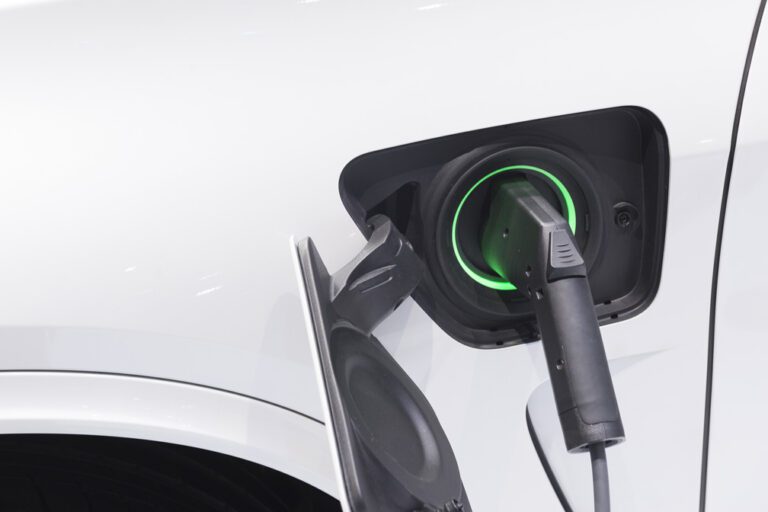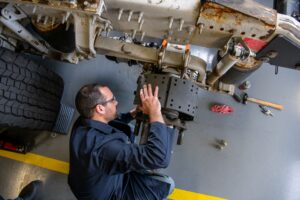WARRENDALE, Pa. – SAE International has published the first Technical Information Report that specifies, in a single document, both electric vehicle and ground-system requirements for heavy-duty wireless charging of EVs.
“SAE TIR J2954/2 Wireless Power Transfer & Alignment for Heavy Duty Applications paves the way for charging HD vehicles without the need for plugging in – widely considered to be a key enabler for accelerating the adoption of EVs and autonomous vehicles,” a news release stated. “This new guideline builds off the success of the first light-duty SAE J2954 standard published in 2020. The SAE TIR J2954/2 exponentially increases the power level of Wireless Power Transfer for heavy-duty vehicles.”
Power is transferred by creating a magnetic resonance field between the ground transmitting assembly and a vehicle assembly fitted on the underbody of an HD vehicle. The energy crosses an air gap — the ground clearance between the pads — and is then converted from AC into DC on the vehicle to charge the vehicle batteries.
“Charging a heavy-duty EV should be as simple as parking in the right spot — the wireless charging SAE TIR J2954/2 Guideline makes it possible to do that automatically,” Jesse Schneider, chair of the SAE Wireless Power Transfer (WPT) Task Force (ZEV Station), said.
SAE International said the technology is a safe and efficient method for transferring power from the AC grid supply to the HD EV.
Field trials using a 10-inch ground clearance have shown that WPT systems operate at grid-to-battery efficiencies of 92% and above. WPT with additional alignment elements in SAE J2954/2 also offers the potential to fulfill charging requirements for autonomous EVs to charge themselves without human interaction.
“The SAE TIR J2954/2 is a game-changer guideline enabling ultra-fast wireless charging to 500kW, for both trucks and buses,” Schneider said. “It also makes it possible for wireless ‘opportunity charging at stops’ for buses to overnight charging without a cord and HD truck sleeper cabs. To top it off, SAE J2954/2 enables dynamic wireless power transfer, making it possible to charge while driving at roadway speeds. This enables a leap forward for wireless charging for EV heavy-duty vehicles by establishing a common vehicle and parking location and frequency.”
SAE J2954 recently published an updated Version 2 of its SAE J2954 light-duty standard for wireless power transfer for electric vehicles. This update improves the standard by creating requirements to assist Underwriter’s Laboratory (UL) 2750 in creating a certification program for SAE J2954 light-duty systems.
“The SAE J2954 Standard has the potential to greatly accelerate validation and therefore commercialization of wireless charging systems for light-duty vehicles,” Jesse Schneider, chair of the SAE WPT Taskforce, added.
“SAE TIR J2954/2 Heavy-Duty Wireless Power Transfer has the potential to change the mindset of fleet operators enabling both transit buses and truck fleets to go electric. It makes the whole prospect of charging easier to handle compared to conductive charging,” Mike Masquelier, sub team co-chair J2954 HD WPT (WAVE), said.
SAE and UL signed a memorandum of understanding to jointly develop and share WPT standards to help accelerate the certification of wireless power transfer for electric vehicles.
“The TIR J2954/2 is a first big step for wireless HD dynamic charging. On-the-go charging will significantly reduce vehicle battery cost, weight and provide a flexible resource to electric utilities,” Dr. Regan Zane, sub team co-chair of dynamic charging (Utah State), said.
The Trucker News Staff produces engaging content for not only TheTrucker.com, but also The Trucker Newspaper, which has been serving the trucking industry for more than 30 years. With a focus on drivers, the Trucker News Staff aims to provide relevant, objective content pertaining to the trucking segment of the transportation industry. The Trucker News Staff is based in Little Rock, Arkansas.








